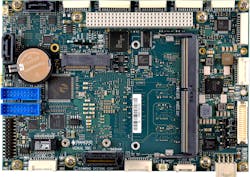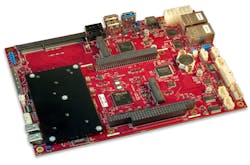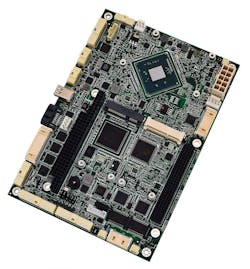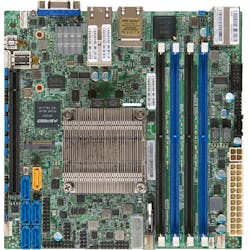Download this article as a .PDF
Embedded motherboard designs change slowly when it comes to peripheral interfaces. ISA-based interfaces like PC/104-Plus remain because it supports legacy boards and it is easy to design peripheral boards, but the interface for the future is PCI Express (PCIe). While there are a host of PCIe daughter board options, the Mini-PCIe form factor offers a compact expansion option for embedded motherboards.
A single Mini-PCIe socket has been commonly found on embedded motherboards for some time, but the number of sockets is increasing as developers are finding more ways to embed peripherals via Mini-PCIe modules. These can often replace the peripherals on legacy boards that take up significantly more space and use more power. The x1 PCIe interface provides sufficient bandwidth for high-speed peripherals, and the multifunction socket can often support interface like SATA in the form of mSATA modules.
Diamond Systems’ Venus (Fig. 1) motherboard supports Intel’s “Skylake” 6th generation Core i7/i5 U series processor. It includes a pair of Mini-PCIe sockets, one of which supports mSATA modules. The single-board computer (SBC) also has PCI-104 and OneBank socket for stackable expansion boards. The OnBank has four x1 PCI Express ports and two USB ports. As with a typical SBC, the Venus includes networking support with a pair of Gigabit Ethernet ports, additional SATA ports, multiple video graphic outputs, and audio support. It has 16 digital ports but lacks analog support that can be easily added using the expansion sockets
VersaLogic’s Viper (Fig. 2) is an EBX SBC that hosts Intel’s Bay Trail Atom processors. It has similar expansion and peripherals as the Venus, although it has PC/104-Plus that includes ISA and PCI sockets. There is a pair of Mini-PCIe sockets with mSATA support. The SBC also has two Gigabit Ethernet ports, plus USB 3.0 support, as well as an 8-channel, 12-bit ADC and 4-channel, 12-bit DAC. The two Mini-PCIe sockets can augment these interfaces or add functionality, such as GPS or wireless networking support.
The WinSystems EPX-C414 (Fig. 3) is similar to the Viper with a Bay Trail processor and two Mini-PCIe sockets. It has 48 digital I/O ports, dual-gigabit Ethernet, and USB 2.0 ports and four serial ports. There is a CFast socket, as well as mSATA support on the Mini-PCIe sockets.
The other expansion port that is becoming more common is the M.2 socket; typically used for storage, it also can support peripherals. It can have up to a x4 PCI Express interface that supports NVMe or a SATA interface (see “What's The Difference Between SATA And NVMe?”). NVMe has the speed advantage, and M.2 modules are available in higher capacities than Mini-PCIe modules, because the M.2 modules can be larger.
Super Microcomputer (SuperMicro) has a number of embedded motherboards that have an M.2 socket as well as a Mini-PCIe socket. The X10SDV-12C-TLN4F (Fig. 4) can run a 12-core Intel Xeon, and it sports a Mini-PCIe and x4 PCIe M.2 socket, along with two 10 Gbit Ethernet ports and two 1 Gbit Ethernet ports.
M.2 has higher capacity storage solutions compared to Mini-PCIe, but there are currently no M.2 modules that match the more rugged specifications of many Mini-PCIe modules. Developers that require high capacities may have to resort to SATA drives that will take up more space.
Motherboards with even more Mini-PCIe and M.2 sockets are becoming available. This allows developers to take advantage of the larger number of PCIe ports available on new systems. This can allow designers to create more compact and flexible systems without the need for daughterboard expansion.
About the Author
William G. Wong
Senior Content Director - Electronic Design and Microwaves & RF
I am Editor of Electronic Design focusing on embedded, software, and systems. As Senior Content Director, I also manage Microwaves & RF and I work with a great team of editors to provide engineers, programmers, developers and technical managers with interesting and useful articles and videos on a regular basis. Check out our free newsletters to see the latest content.
You can send press releases for new products for possible coverage on the website. I am also interested in receiving contributed articles for publishing on our website. Use our template and send to me along with a signed release form.
Check out my blog, AltEmbedded on Electronic Design, as well as his latest articles on this site that are listed below.
You can visit my social media via these links:
- AltEmbedded on Electronic Design
- Bill Wong on Facebook
- @AltEmbedded on Twitter
- Bill Wong on LinkedIn
I earned a Bachelor of Electrical Engineering at the Georgia Institute of Technology and a Masters in Computer Science from Rutgers University. I still do a bit of programming using everything from C and C++ to Rust and Ada/SPARK. I do a bit of PHP programming for Drupal websites. I have posted a few Drupal modules.
I still get a hand on software and electronic hardware. Some of this can be found on our Kit Close-Up video series. You can also see me on many of our TechXchange Talk videos. I am interested in a range of projects from robotics to artificial intelligence.






